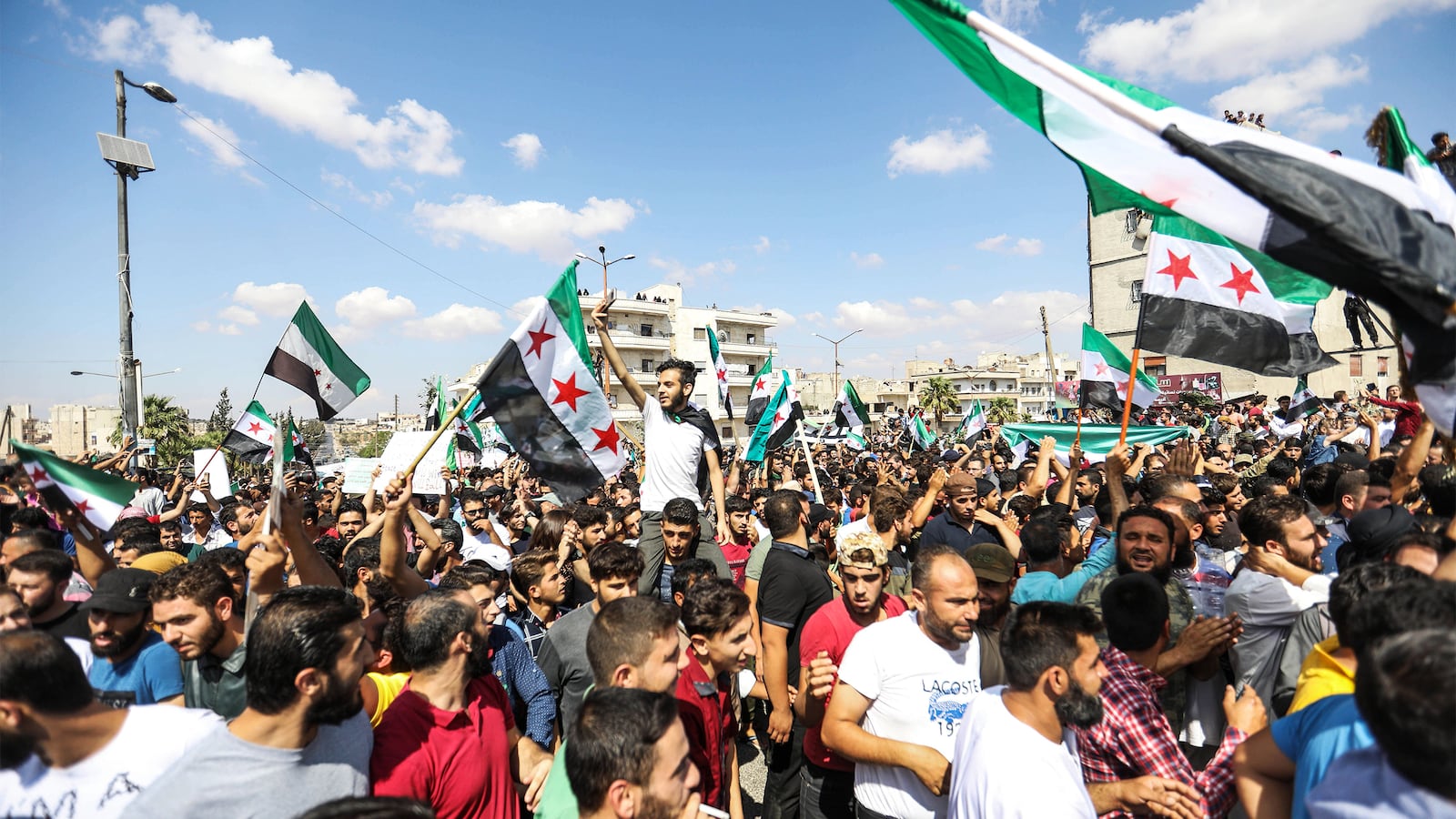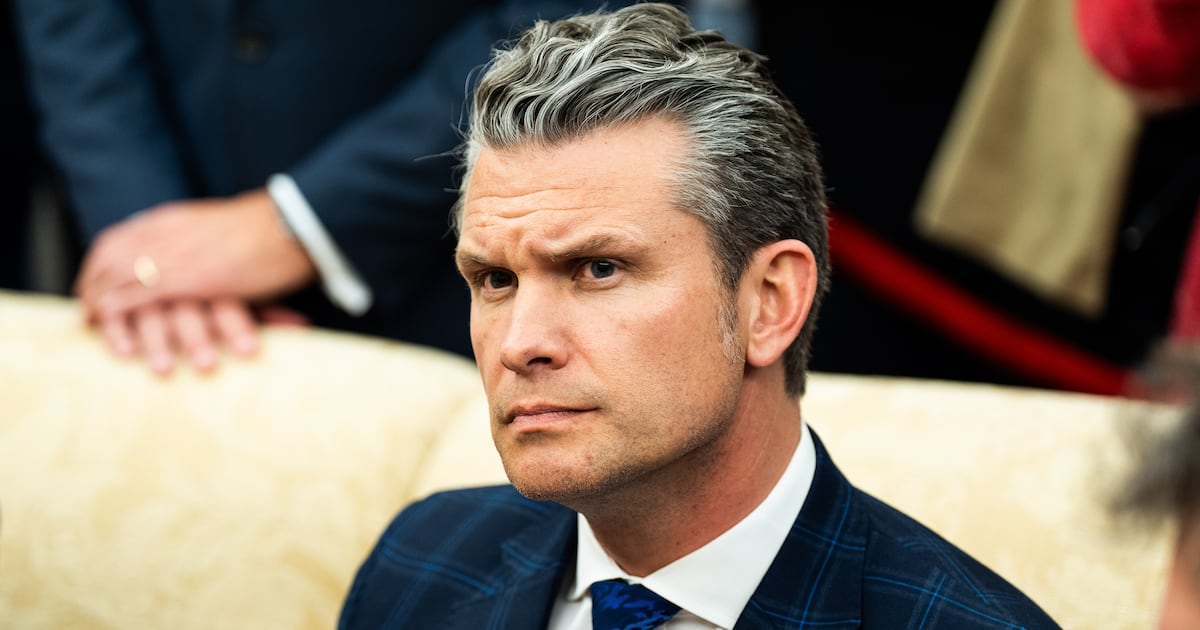This story was reported in collaboration with Frontline .
ISTANBUL—Just a week after Syria’s northern Idlib province seemed on the brink of a massive military assault by the regime of Syrian President Bashar al-Assad backed by Russian air power, tens of thousands of defiant residents took to the streets of Idlib province and beyond on Friday in demonstrations calling for the overthrow of the Assad regime.
They may be far from that goal, but it appears that the threat of annihilation has abated as well.
The impending military operation feared by those on the ground and condemned by Turkey, European nations, and the United States, has not happened.
For the past four days, there have been no airstrikes, no major shelling incidents, no menacing movements of troops. Instead, there is a growing sense that the threat from the regime and Russia had been suspended.
The hiatus began unannounced Tuesday. “We absolutely see something of a pause,” a U.S. defense official said. “We’re not willing to define why at this point.”
The tone for the week was set on Tuesday in Geneva, when Russia’s special envoy in Syria, Alexander Lavrentiev, told reporters it was up to Turkey to rid the province of extremists. “We are saying that the situation in Idlib should be settled most preferably in a peaceful way. It is possible to abstain from using military force,” he said, according to Reuters. “Idlib province is… a sort of zone of responsibility for Turkey; it is their responsibility to separate the moderate opposition from the extremists, from Jebhat al Nusra and other groups, other terrorist groups.”
Nusra is one of the names of a group originally and officially affiliated with al Qaeda.
The Turkish foreign ministry declined to comment on the break in the assault, and the Russian embassy in Ankara referred all questions to the Foreign Ministry in Moscow.
The State Department said the U.S. government was closely monitoring “the possible suspension” of operations.
“We are not aware of any agreement related to a cease-fire, but a cessation of the military escalation by the Assad regime would be a welcome development,” a State Department official said. The U.S. had warned top Russian officials that a military offensive “would be a reckless escalation” of the Syria conflict.
Lavrentiev set a very different tone than that used by Russian President Vladimir Putin, who just a week ago at a summit in Tehran brusquely dismissed a public appeal for a ceasefire from his Turkish counterpart, Recep Tayyip Erdogan.
Russia and Iran have been the principal outside backers for Assad. The combination of the Russian air war and Iranian-backed militias have enabled Assad to prevail up to now against the moderate rebel forces while U.S.-backed forces did the heavy lifting against the so-called Islamic State.
Until this week, Russia and Iran appeared to be on course to launch a major offensive to recapture the last rebel-held province.The first sign of a climbdown came from Iranian President Hassan Rouhani who repeatedly voiced concern at the Tehran summit for the protection of civilians in any military operation. This translated into a very significant shift on the ground, where Lebanese Hezbollah and other Iranian-backed forces were not deploying in locations close to the expected battle fronts.
A second major sign that the offensive might be suspended was the absence of a build-up by Syria’s own forces, which have been deeply eroded by seven years of fighting and a flood of desertions and defections to moderate rebel forces.
The regime had at most 25,000 ground troops based in the region, according to military leaders of the Syrian opposition, and had brought in at most 5,000 reinforcements. But the reinforcement included new conscripts drawn from rebel forces defeated in Dara’a in southern Syria, soldiers whose loyalty will be in question. In fact, opposition leaders say that one third of the first group of 100 brought in from Dara’a had defected shortly after being brought near the front.
One of the most effective fighting units in Assad’s security establishment is the so-called Tiger Forces, an elite formation under the command of Suheil al-Hassan, a major general in the Syrian army. But that force has been redeployed well to the east in the war-battered ancient city of Palmyra, according to a report on the opposition Orient TV. Defected Gen. Ahmad Rahal, a senior rebel commander, confirmed the report.
U.S. defense officials said the forces lined up by the regime appeared insufficient for a ground offensive. “It could be delayed for weeks,” an official said. “We don’t think they have the forces to do it.”
“Lavrentiev’s statement and the Syrian government’s redeployment of the Tiger Forces and Suheil al-Hassan himself to Palmyra—if confirmed—are strong indicators that they are delaying the offensive and giving Turkey the green light to move in and eliminate HTS,” said Columb Strack, a Middle East analyst for IHS Markit, the parent company of Jane’s defense publications. He said Turkey’s deployment of additional armored units into Idlib is also in line with this scenario.
These developments appear to have imbued the opposition with new confidence, leading to the many demonstrations around Idlib and parts of other provinces still under rebel control.
“Raise your hands and say we don’t want Bashar,” was the cry in the rebel-held town of Al Dana, while in the village of Kfarruma they chanted, “We will not kneel but to God.”
In Latamna, which has endured constant shelling for most of the last year, townspeople chanted, “We prefer death rather than humiliation.”
There were demonstrations in at least 47 cities and villages of Idlib, 20 locations in areas of Aleppo province under rebel control and a dozen areas in Hama, according to a tally based on internet postings and interviews with activists by The Daily Beast/Frontline. “There is no alternative to toppling the regime,” was the theme chosen by opposition leaders.
In many places, demonstrators paraded the Turkish flag as well as the green, white and black flag of the Syrian revolution, a sign of Turkey’s popularity for its determined efforts to head off a major military operation.
But Idlib province, packed with 3.5 million people, the majority driven from rebel territories recaptured by regime forces, has another security threat—from radical Islamists, including supporters of al Qaeda. Their presence could still provide the pretext for a regime and Russian military intervention.
At Atmah refugee camp, which lies on the Turkish border, residents parading the flag of the Syrian revolution encountered a smaller protest group, who raised the flag of Hay'at Tahrir al-Sham (HTS), which, formally at least, has dropped all ties with al Qaeda. A few of the HTS demonstrators raised the black flag of al Qaeda. A fistfight broke out, and the demonstrators dispersed.
In Idlib city, the provincial capital, HTS, which controls security, brought out 60 or 70 supporters with HTS flags, but they avoided the far larger demonstration staged by the moderate opposition backers. In Saraqeb, where thousands from the city and surrounding villages filled a soccer pitch, five young men carrying HTS flags showed up outside the grounds with the HTS flag, but left a few minutes later after taking selfies, local activists reported.





